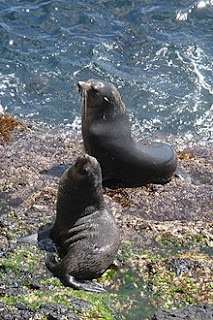 |
| Agulhas II will offload scientists and gear at Tristan, Nightingale, and Gough Islands. |
Antje Steinfurth is on her fourth trip to Tristan Island to study the Northern Rockhopper penguin population, called pinnamins by the locals. 85% of the population breeds on Gough and Tristan Islands. The two islands are 380 kilometers apart (236 miles), but there's a front that crosses through the ocean there that creates a very different environment around each, including a temperature gradient that influences the dominant food source for penguins. I'll see this for myself in the next few days, and we're specifically deploying one of the SOCCOM floats right along that oceanographic boundary. In 2011, an oil spill from a ship that ran aground on Nightingale Island created an environmental disaster and seriously affected the beloved penguins (see more pictures here). Since then, the locals have partnered with government agencies to support scientific studies to monitor the population. Some have been micro-chipped, much like a cat or dog, so that they can be tracked. Antje has set up a scanner that the penguins have to cross in order to get in between the ocean and the nesting grounds. So it counts each individual as they go back and forth.
 |
| Subantarctic fur seals live on the islands by the thousands. |
There's also a French project called Enviroearth that uses monitoring stations on remote islands to detect nuclear explosions. There are arrays of sensors on the ground that pick up seismic waves and some in the air that can detect even the smallest amount of radioactive isotopes. After the madness of the 20th century, an international treaty in 1995 ended nuclear testing. Since then only six detonations have happened (looking at you North Korea). The scientists are also installing renewable energy in the form of solar panels and heaters on houses on the island.
The South African Weather Service has scientists onboard, a few of who will get off at Gough Island to spend a year taking measurements at the station there. It's been monitored for nearly 60 years and the station is getting old, so one of the technicians is stopping at Tristan Island in order to assess relocating the weather station there. Because of the previously mentioned environmental differences between the islands, this raises questions about data continuity. A few of the weather service employees will stay on the ship for the whole trip. They report weather conditions every three hours, which is used to help the captain make navigation decisions, and the data goes to ground truth climate models based on satellite data. On the run south after we leave Gough Island, they will deploy weather balloons and drifting buoys that will further add to the data set.
So there's a lot going on! This is in addition to the 10 scientists who will get off to spend a year on Gough Island, as well as a married couple who will study land birds on Nightingale Island, completely cut off from the rest of the world for six months. And here I thought I lived remotely for long periods of time in order to do science - all of a sudden this five week cruise doesn't seem like such a sacrifice.
One year later and still think fondly of this voyage. So lovely to read this blog, relive all of these amazing memories and feel a great sense of pride in our science collaborations and beloved SA Agulhas II. As we gear up for Gough Island 2018, Melissa, your presence is missed and sincerely hope we'll meet on the high seas in the future!
ReplyDelete